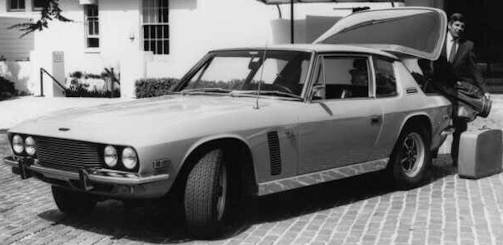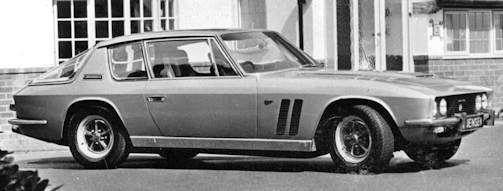Jensen Interceptor MK1
 |
|
|
Production period: |
1966 to 1969 |
|
Class: |
sports car |
|
Body versions: |
coupe |
|
Engines: |
V8 6.3 liters |
|
Length: |
188 in, 4,775 mm |
|
Width: |
69 in, 1,753 mm |
|
Height: |
58 in, 1,473 mm |
|
wheelbase : |
105 in, 2,667 mm |
|
curb weight : |
1,590 1b, 721 kg |
|
previous model |
Jensen C-V8 |
The Interceptor mark I was a sports GT car from the 1960s by the British manufacturer Jenson built from 1966 to 1969.
History
Jensen had already used the term Interceptor in 1950 for a predecessor, which is now usually referred to as the "Early Interceptor" . The Interceptor formed the basis for the Jensen SP and for the all-wheel drive Jensen FF model .
Jensen Motors was a British coachbuilder that primarily manufactured car bodies to order for high volume manufacturers. Since the 1950s, Jensen has manufactured the Austin Healey , among others . In addition, Jensen produced a small number of expensive sports cars under its own name, for which Jensen mostly used large-scale production technology. In the early 1960s, this was primarily the Jensen C-V8 , a luxury coupe with drive technology from Chrysler. The C-V8 was not successful; A major reason for this was the unusual body designed by Jensen's designer Eric Neale, which was perceived by observers as outdated and sometimes also as ugly. In 1964 considerations began for a successor to the C-V8, which finally culminated in the Interceptor presented in 1966. The development of the Interceptor was preceded by considerable controversy in Jensen's management, with Richard and Alan Jensen, the company's founders, on the one hand, and the managers of the Norcros Group, to which Jensen had majority ownership since 1957, opposing each other.

The Interceptor is believed to be the child of Kevin Beattie, a South African-born engineer who had worked for Jensen since 1960 and had since risen to Technical Director. On his behalf, Eric Neale first designed the P66 together with Richard Jensen , a two-door sports car whose market position was located below that of the C-V8. This concept did not catch on. Neither Beattie nor the managers of the Norcros group considered the P66 suitable to secure the future of the brand. Norcrosfelt that the car was too small and Beattie disliked what he considered to be the car's overly traditional bodywork. Instead, Norcros management opted for an immediate, i. H. to develop a successor to the C-V8 positioned in the same market segment, which, like the competing models from Aston Martin and Gordon-Keeble , should have a body designed in Italy.
Beattie commissioned Milan's Carrozzeria Touring to design; at the same time, their Turin competitors Vignale and Ghia were also asked for suggestions. Ultimately, the touring design was approved by Norcros . Richard and Alan Jensen, the company's founders, as well as longtime design chief Eric Neale, opposed Beattie's concept in general and the Touring design in particular. When Norcros decided to produce the Touring model, the Jensen brothers and Neale left the company after a dispute.The prototype was made by Vignale. The car made its debut at the Earls Court Motor Show in October 1966.
The Jensen Interceptor remained in production for 11 years. During this time, around 7,200 vehicles were built in three series. During the production period, the company experienced considerable economic turbulence, which was mainly triggered by the cancellation of the production order for the Austin Healey without replacement. At the beginning of the 1970s there was a change of ownership; Jensen was taken over by US entrepreneur Kjell Qvale, who continued Interceptor production without initiating the development of a successor. As a result of the first oil crisis , the company went bankrupt in 1975, after which Jensen stopped producing cars. A successor company called Jensen Parts and Service took over the supply of spare parts and service for existing vehicles and also manufactured some new vehicles in the late 1980s.

Structure and technology
The body of the Interceptor bore neither external nor technical resemblance to the C-V8. While the body of the C-V8 and its predecessor 541 was made of glass fiber reinforced plastic , the body of the Interceptor was made of steel.
The Interceptor was created in three body versions. The basic and by far the most produced version was a closed two-door hatchback known as a saloon, whose outstanding design feature was a large panoramic rear window that also served as a tailgate. From this model, a two-door convertible .A controversy arose over the authorship of the Touring design. The Swiss Jensen importer and later sports car manufacturer Peter Monteverdi ( Automobile Monteverdi ) claimed into the 1970s that he designed the body of the Interceptor for Touring. Eventually, Monteverdi filed a lawsuit in Britain, which was unsuccessful.
Instead of the Carrozzeria Touring, which was badly hit economically and was dissolved at the end of 1966 , Vignale received the order to manufacture the prototype. The first 50 series bodies were also made at Vignale. From 1967, however, Jensen manufactured the entire vehicle itself at its plant in West Bromwich .
Chassis and drive technology
As in the previous C-V8, Jensen used a 6.3-liter eight-cylinder engine from Chrysler for the models in the first series . It delivered 330 hp at 4,600 rpm. A three-stage TorqueFlite automatic transmission, also built by Chrysler, served as standard power transmission.In deviation from this, 23 vehicles were equipped with a manually shifted four-speed gearbox at the customer's request. The vehicles of the first series were not yet equipped with power steering . Externally, the first series can be recognized by narrow, low-lying bumpers; the front turn signals were installed above the bumper.
- PERFORMANCE
- Engine capacity: 383 cu in, 6,276.22 cu cm
- Fuel consumption: 17 m/imp gal, 14.2 mlUS gal, 16.6 1 x 100 km
- Max speed: 130 mph, 209.3 km/h
- max power (SAE): 330 hp at 4,600 rpm
- max torque (SAE): 425 1b ft, 58.6 kg m at 2,800 rpm
- max engine rpm: 5,000
- specific power: 52.6 hp/l
- power-weight ratio: 4.9 lb/hp, 2.2 kg/hp
- acceleration: standing 1/4 mile 14.6 sec.
- max speeds: 48 mph, 77.3 km/h in 1st gear; 82 mph, 132 km/h in 2nd gear; 130 mph, 209.3 km/h in 3rd gear
For the Interceptor, Jensen took over the tube frame chassis from its predecessor , which was largely designed by Kevin Beattie, as well as the basic features of the suspension. As there, the front wheels were individually suspended on double wishbones with coil springs, at the rear Jensen used a rigid axle with leaf springs and Panhard rod .
As in the previous model, it was powered by an eight-cylinder engine that Jensen obtained from Chrysler . These were so-called big-block engines. Initially, Jensen used a 6.3 liter (383 cu in) B-series version. After Chrysler discontinued production of this engine, which had been introduced in 1958.The power was transmitted by an automatic three-speed gearbox from Chrysler (type Torque Flite). A fully synchronized manual four-speed gearbox was initially available for the first series saloons, but this was only ordered 23 times.

Jensen FF
The Jensen FF was the first production car with all-wheel drive and a mechanical anti-lock braking system (ABS). Formally, the FF was not an interceptor, but a separate series. The four-wheel drive required more space, so the entire stem had to be lengthened. Even if the FF looks quite similar to an Interceptor, it is easily recognizable by the modified front end with double side vents. It was built until 1971. In total 320 FFs were produced.
The production
1024 Mk1 built A total of 6640 units were manufactured, taking into account pre-series vehicles as well as SP-type vehicles.
Technical
-
Jensen Interceptor MK 1 Technical details and specifications (1966-1969)
ENGINE
front, 4 stroke (Chrysler)
cylinders: 8, Vee-slanted at 90°
bore and stroke : 425 x 3.38 in, 107.9 x 85.9 mm
engine capacity: 383 cu in, 6,276.22 cu cm
compression ratio: 10
cylinder block: cast iron
cylinder head: cast iron
crankshaft bearings: 5; valves: 2 per cylinder, overhead, in line, push-rods and rockers, hydraulic tappets
camshafts: 1. at centre of Vee
lubrication: rotary pump, full flow filter
carburation: 1 Carter downdraught 4-barrel carburettor
fuel feed: mechanical pump
cooling system: waterTRANSMISSION
driving wheels: rear
gearbox: Torqueflite automatic, hydraulic torque convertor and planetary gears with 3 ratios + reverse
gearbox ratios: I 2.443, II 1.446, III 1, rev 2.195
final drive: hypoid bevel, limited slip
axle ratio: 3.070.
(Optional) 4-speed mechanical gearbox (I 2.658, II 1.909, III 1.388. IV 1, rev 2.580)
(Optional) FF Ferguson 4-wheel drive without limited slip driveCHASSIS
type tubular
front suspension: independent, wishbones, coil springs, anti-roll bar, lever dampers
rear suspension: de Dion rigid axle, semi-elliptic leaf-springs, transverse linkage bar, lever dampers electrically adjustable while running.STEERING
rack-and-pinion
turns of steering wheel lock to lock: 3.30.
(Optional) power-assisted steering, 2.57 turns of steering wheel lock to lockBRAKES
disc (diameter 11.50 in, 292 mm), independent front and rear circuits, servo
area rubbed by linings: total 498 sq in, 3,212.10 sq cm.
(Optional) brakes with Dunlop-Maxaret anti-skid device, front track 55.87 in, 1,419 mmELECTRICAL EQUIPMENT
voltage: 12 V; battery
72 Ah
generator type: alternator, 40 Ah
ignition distributor: ChryslerDIMENSIONS AND WEIGHT
wheel base:105 in, 2,667 mm
front track: 55.81 in, 1,418 mm
rear track: 55.87 in, 1,419 mm
overall length: 188 in, 4,775 mm
overall width: 69 in, 1,753 mm
overall height: 58 in, 1,473 mm
ground clearance: 5.50 in,140 mm
dry weight: 1,590 1b, 721 kg
turning circle (between walls): 38 ft,11.6 m© Motor car History
Service
-
Jensen Interceptor MK 1 Maintenance and Service Guide (1966-1969)
Fuel: 95 oct petrol
Engine sump oil: 8.50 imp pt. 10.15 US pt. 4.8 1, SAE 10W-30, change every 4,000 miles, 6,400 km
Total lubricating system capacity: 9 imp pt, 10.78 US pt, 5.1 1
Gearbox oil: 17 imp pt. 20.51 US pt. 9.7 1, automatic transmission fluid type A, change every 36,000 miles, 58,000 km
Final drive oil: 3 imp pt, 3.59 US pt, 1.7 1, SAE 90, change every 12,000 miles, 19,300 km
Cooling system capacity: 32 imp pt, 38.47 US pt, 18.2 1.
Greasing: every miles, 1,600-6,400 km, 6 points
Valve timing: inlet opens 18° before tdc and closes 58° after bdc, exhaust opens 66° before bdc and closes 14° after tdc
Normal tyre pressure: front 24 psi tyres: 6.70 x 15Fuel tank capacity: 16 imp gal, 19.3 US gal, 73 1
Carrying capacity: 706 1b, 320 kg© Motor car History
